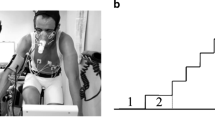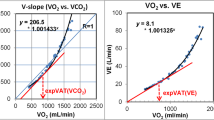Abstract
A new graphical method for determining the anaerobic threshold (AT), which has been experimentally tested in testing the maximal aerobic capacity in 46 cyclic sports athletes (mean age, 20.3 ± 3.6 years; body weight, 68.3 ± 10.4 kg). The gas exchange indices, the heart rate, the time of onset (from the beginning of the test) of AT by pulmonary gas exchange ratios, the non-metabolic CO2 excess, the concentration of lactate in capillary blood, and the time of onset of AT determined by the proposed graphical method by the parameters of the pulsogram obtained during the test and 10-min recovery were determined. Two different protocols of load change—the incremental ramp test on a treadmill and the incremental step test on a bicycle ergometer—were used. Regardless of the protocol and the load type, statistical analysis revealed no significant differences between the results of AT measurements in the same athletes by the gas exchange and lactate dynamics indices, on the one hand, and by using the graphical method by the pulsogram parameters, on the other hand. In the test with a stepwise increase in load on a bicycle ergometer, as well as in the test with a smoothly increasing load on a running treadmill, the indices obtained at the AT that was determined by using the graphical method highly correlated with the indices obtained at the AT that was determined by analyzing the dynamics of pulmonary ventilation, non-metabolic CO2 excess, and lactate concentration (p < 0.05). The proposed method does not require the use of sophisticated equipment and invasive procedures and can be widely used in sports and fitness practice.

Similar content being viewed by others
REFERENCES
Joyner, M.J. and Coyle, E.F., Endurance exercise performance: the physiology of champions, J. Physiol., 2008, vol. 586, no. 1, p. 35.
Lundby, C. and Robach, P., Performance enhancement: what are the physiological limits? Physiology (Bethesda), 2015, vol. 30, p. 282.
MacDougall, J.D., Wenger, H.A., and Green, H.J., Physiological Testing of the High Performance Athlete, Champaign, IL: Human Kinetics, 1991.
Seluyanov, V.N., Kalinin, E.M., Pack, G.D., et al., Estimation of the anaerobic threshold from the data on lung ventilation and heart rate variability, Hum. Physiol., 2011, vol. 37, no. 6, p. 733.
Mourot, L., Fabre, N., Savoldelli, A., and Schena, F., Second ventilatory threshold from heart-rate variability: valid when the upper body is involved? Int. J. Sports Physiol. Perform., 2014, vol. 9, p. 695.
Buchheit, M., Solano, R., and Millet, G.P., Heart-rate deflection point and the second heart-rate variability threshold during running exercise in trained boys, Exercise Sci., 2007, vol. 19, p. 192.
Mendia-Iztueta, I., Monahan, K., Kyröläinen, H., and Hynynen, E., Assessment of heart rate variability thresholds from incremental treadmill tests in five cross-country skiing techniques, PLoS One, 2016, vol. 11, no. 1, p. e0145875.
Conconi, F., Ferrare, M., Ziglio, P.G., et al., Determination of the anaerobic threshold by a non-invasive field test in runners, J. Appl. Physiol., 1982, vol. 52, no. 4, p. 869.
Jones, A.M. and Doust, J.H., Lack of reliability in Conconi’s heart rate deflection point, Int. J. Sports Med., 1995, vol. 16, no. 8, p. 541.
Jones, A.M. and Doust, J.H., The Conconi test is not valid for estimation of the lactate turnpoint in runners, J. Sports Sci., 1997, vol. 15, no. 4, p. 385.
Weltman, A., Snead, D., Seip, R., et al., Prediction of lactate threshold and fixed blood lactate concentrations from 3200-m running performance in male runners, Int. J. Sports Med., 1987, vol. 8, no. 6, p. 401.
Vachon, J.A., Bassett, D.R., and Clarke, S., Validity of the heart rate deflection point as a predictor of lactate threshold during running, J. Appl. Physiol., 1999, vol. 87, no. 1, p. 452.
Kuipers, H., Keizer, H.A., Vries, T., et al., Comparison of heart rate as a non-invasive determinant of anaerobic threshold with the lactate threshold when cycling, Eur. J. Appl. Physiol., 1988, vol. 58, no. 3, p. 303.
Tokmakidis, S. and Léger, L., Comparison of mathematically determined blood lactate and heart rate “threshold” points and relationship with performance, Eur. J. Appl. Physiol., 1992, vol. 64, no. 4, p. 309.
Walker, J. and Eisenman, P., Validity of a heart rate inflection point or a 3.2 kilometer performance pace as estimators of maximal steady-state running velocity in high school runners, Sports Med. Train. Rehab., 1995, vol. 6, no. 3, p. 215.
Thorland, W., Podolin, D., and Mazzeo, R., Coincidence of lactate threshold and HR-power output threshold under varied nutritional states, Int. J. Sports Med., 1994, vol. 15, no. 6, p. 301.
Wasserman, K., Hansen, J.E., Sue, D.Y., et al., Principles of Exercise Testing and Interpretation, Baltimore, MA: Williams and Wilkins, 1999, 3rd ed.
Cheng, B., Kuipers, H., Snyder, A.C., et al., A new approach for the determination of ventilatory and lactate thresholds, Int. J. Sports Med., 1992, vol. 13, no. 7, p. 518.
Master, A.M. and Oppenheimer, E.T.B., A simple exercise tolerance test for circulatory efficiency with standard tables for normal individuals, Am. J. Med. Sci., 1929, vol. 177, p. 223.
Letunov, S.P. and Motylyanskaya, R.E., Determination of the condition of athletes training: problems of sports medicine, in Metody vrachebno-fiziologicheskikh issledovanii sportsmenov (Methods of Medical and Physiological Examinations of Athletes), Moscow: Fizkul’tura i Sport, 1972, p. 6.
Sonkin, V.D. and Tambovtseva, R.V., Razvitie myshechnoi energetiki rabotosposobnosti v ontogeneze (Development of Muscular Energy of Working Capacity in Ontogenesis), Moscow: Librokom, 2011.
Margaria, R., Edwards, H.T., and Dill, D.B., The possible mechanisms of contracting and paying the oxygen debt and the role lactic acid in muscular contraction, Am. J. Physiol., 1933, vol. 106, no. 3, p. 689.
Margaria, R., Biochemistry of muscular contraction and recovery, J. Sports Med. Phys. Fitness, 1963, vol. 3, p. 145.
Margaria, R., Cerretelli, R., di Prampero, P.E., et al., Kinetics and mechanism of oxygen debt contraction in man, J. Appl. Physiol., 1963, vol. 18, no. 2, p. 371.
Atkinson, D.E., Energy charge of the adenylate pool as a regulatory parameter. Interaction with feedback modifiers, Biochemistry, 1968, vol. 7, no. 11, p. 4030.
Atkinson, D.E., Cellular Energy Metabolism and Its Regulation, New York: Academic, 1977, p. 151.
Demin, V.I., Parameters of mitochondria electron transport chain conditions, anaerobic glycolysis, and creatine kinase system in skeletal muscles during ontogenesis, in Osobennosti razvitiya fiziologicheskikh sistem shkol’nika (Physiological Systems Developmental Specificities in Schoolchildren), Moscow: Prosve-shchenie, 1983, p. 77.
Edwards, H.T., Interaction of chemical with electromechanical factors in human skeletal muscle fatigue, Acta Physiol. Scand. Suppl., 1986, vol. 556, p. 149.
Wyss, M. and Kaddurah-Daouk, R., Creatine and creatinine metabolism, Physiol. Rev., 2000, vol. 80, no. 3, p. 1107.
Sjöholm, H., Sahlin, K., Edström, L., and Hultman, E., Quantitative estimation of anaerobic and oxidative energy metabolism and contraction characteristics in intact human skeletal muscle in response to electrical stimulation, Clin. Physiol., 1983, vol. 3, p. 227.
Harris, R.C., Sahlin, K., and Hultman, E., Phosphagen and lactate contents of m. quadriceps femoris of man after exercise, J. Appl. Physiol., 1977, vol. 43, p. 852.
Margaria, R., Biomechanics and Energetics of Muscular Exercise, Oxford: Clarendon, 1976, p. 146.
Cerretelli, R., Oxygen debt: definition, role and significance, in Medicine and Sport Sciences: Physiological Chemistry of Training and Detraining, Basel: Karger, 1984, vol. 17, p. 68.
Author information
Authors and Affiliations
Corresponding authors
Additional information
Translated by M. Batrukova
Rights and permissions
About this article
Cite this article
Kozlov, A.V., Yakushkin, A.V., Andreev, R.S. et al. A Method for the Evaluation of Anaerobic Threshold Based on Heart Rate Dynamics during Incremental Exercise Test and Recovery. Hum Physiol 45, 180–187 (2019). https://doi.org/10.1134/S0362119719020038
Received:
Revised:
Accepted:
Published:
Issue Date:
DOI: https://doi.org/10.1134/S0362119719020038




